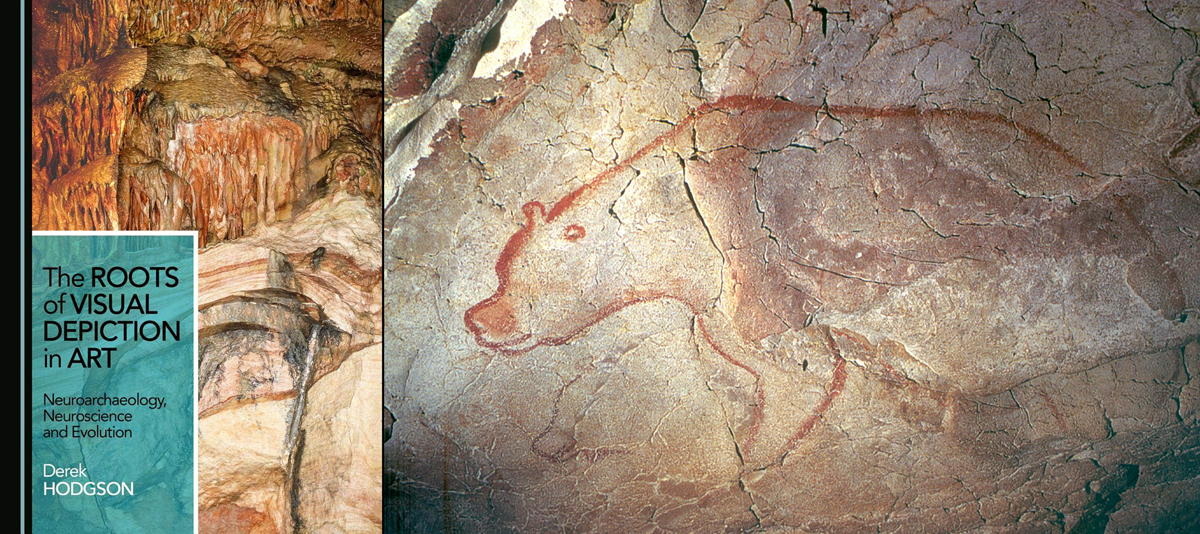


'The Roots of Visual Depiction in Art: Neuroarchaeology, Neuroscience and Evolution'
By Derek Hodgson
Derek Hodgson's recent publication 'The Roots of Visual Depiction in Art: Neuroarchaeology, Neuroscience and Evolution' illustrates how neuroscience provides new insights into why ancient hunter-gatherers first began to create images of animals. He carefully considers the deep evolutionary precursors influencing brain function as well as the ethological and environmental context that influenced behaviour.

The author explains that representational art is intimately associated with how the visual system funtions; after all, vision in humans constitutes the dominant sensory modality. The central premise is that the detection of animals would have been crucial to the survival of palaeo-people during the Ice Age, not just whilst hunting but also during everyday activities when predators needed to be avoided. Identifying animals was one of the key factors that led to the advancement of the human visual system.
Not that our ancestral hunter-gatherers would have discussed this; they would have been unaware that this complex and unique visual mechanism allowed the world to be discerned. Nor did they think of this phenomenon as a means of observing the beauty of the world. It was a form of high vigilence that favoured survival.'Extinction awaited any primate who regarded a plant or animal as a thing of beauty rather than a potential source of food or a threat'.
The author explains that Upper Palaeolithic image making was intricately linked to activities associated with animals - hunting, defending, and everything in between. The author argues that the typical 'profile' depiction of animals demonstrates how visual imagery and visual memory best presented information about animals. Recent brain imaging techniques have shown that there is a discrete area off the human temporal cortex devoted to natural things. Within that area there are further regions dedicated to encoding animals. This important module in the temporal lobes is a result of long standing evolutionary determinants, and is still deeply rooted in the cortex.
Hodgson's analysis of prehistoric art in this publication is very extensive; he covers so much ground. One particular aspect I enjoyed, and one which I feel is underrepresented, is his explanation of a changing perspective of art. During the Upper Palaeolithic animals and humans were on an equal footing. This, however, began to change some 30,000 years ago as humans gained the ascendancy. Carnivores and large herbivores were gradually becoming extinct due to changing environmental and climatic conditions as well as human ascendancy. 'We are now the masters and you, the animals, are henceforward the pursued'. And so too the art was gradually changing. Individual animals in profile were giving way to hunting scenes that were more stylized - or schematic - in design. The Upper Palaeolithic, the Mesolithic and the Neolithic all had their own art galleries.
While Hodgson isn't the first writer to analyse rock art using the neuroscientific lense, 'The Roots of Visual Depiction in Art' takes a realm of science that may intimidate many and links it with a genre of art that attracts us all. The result is a perspicacious, challenging and exciting publication that will appeal to the general reader as well as the specialist.
by Bradshaw Foundation
Tuesday 19 November 2024
by Bradshaw Foundation
Wednesday 22 May 2024
by Bradshaw Foundation
Friday 10 November 2023
by Bradshaw Foundation
Thursday 12 January 2023
by Bradshaw Foundation
Thursday 10 November 2022
by Bradshaw Foundation
Tuesday 06 September 2022
by Bradshaw Foundation
Wednesday 20 July 2022
by Bradshaw Foundation
Monday 20 June 2022
by Bradshaw Foundation
Thursday 03 September 2020
by Bradshaw Foundation
Wednesday 26 August 2020
by Bradshaw Foundation
Saturday 27 June 2020
by Bradshaw Foundation
Tuesday 28 April 2020
by Bradshaw Foundation
Tuesday 19 November 2024
by Bradshaw Foundation
Wednesday 22 May 2024
by Bradshaw Foundation
Friday 10 November 2023
by Bradshaw Foundation
Thursday 12 January 2023
by Bradshaw Foundation
Thursday 10 November 2022
by Bradshaw Foundation
Tuesday 06 September 2022
by Bradshaw Foundation
Wednesday 20 July 2022
by Bradshaw Foundation
Monday 20 June 2022
by Bradshaw Foundation
Thursday 03 September 2020
by Bradshaw Foundation
Wednesday 26 August 2020
by Bradshaw Foundation
Saturday 27 June 2020
by Bradshaw Foundation
Tuesday 28 April 2020
Friend of the Foundation











